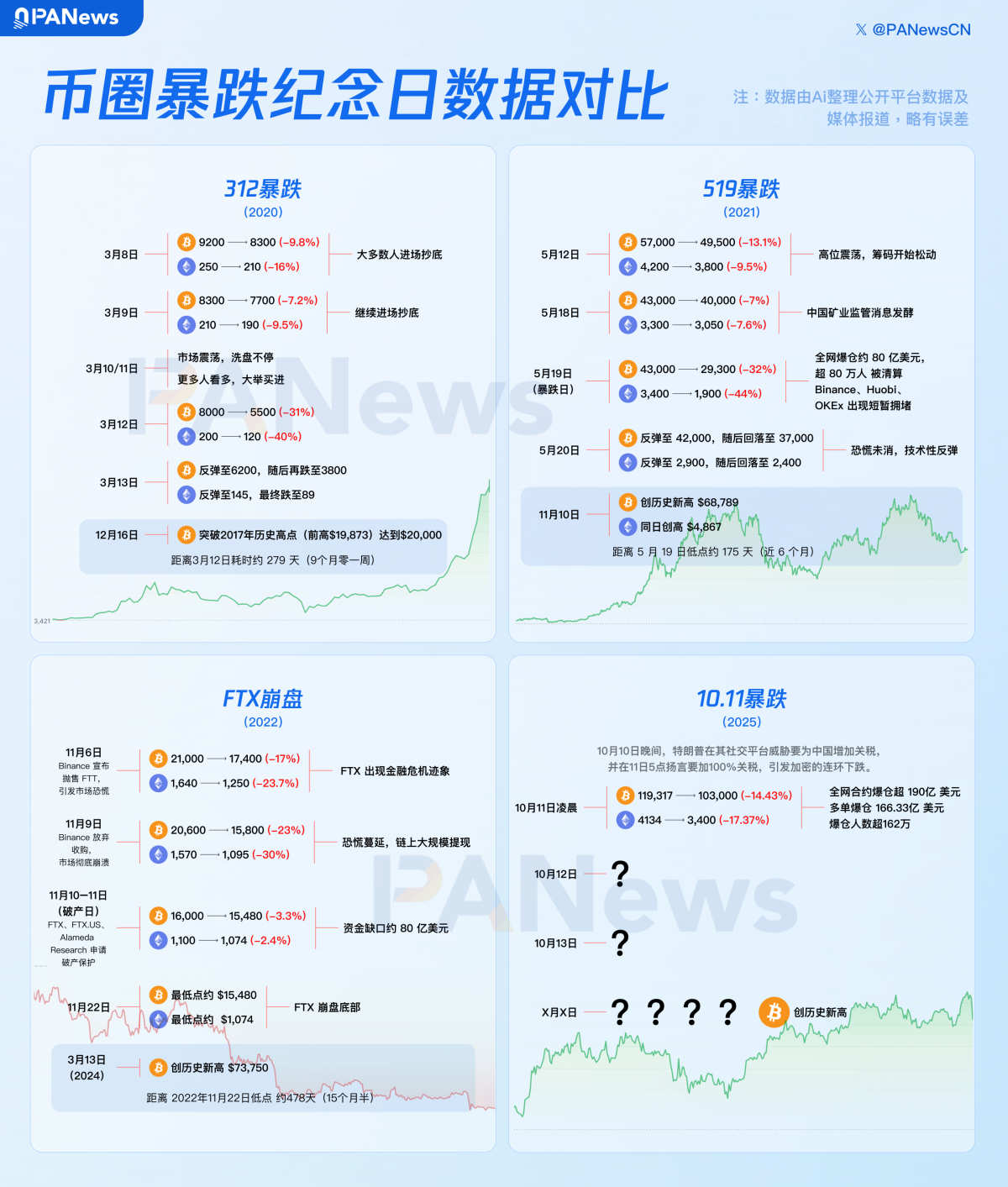After the ‘Major Crypto Shakeup’: Bitcoin Resilience Persists, What’s Next for Altcoins?
October 11, 2025
Author: Nancy, PANews
In the early hours of October 11, a shocking scene unfolded in the cryptocurrency market. Major coins like Bitcoin experienced sharp flash crashes from high positions, while altcoins plummeted dramatically akin to a ‘free-fall ride.’ Within a few short hours, nearly $20 billion in leveraged funds were liquidated entirely, setting a record for the largest margin call in crypto history.
This sudden storm was a chain reaction triggered by abrupt changes in macro policy expectations, excessive leverage, and a sharp drop in liquidity, compounded by rapidly escalating panic. The result was an epic cascade of liquidations. In the aftermath of this historic deleveraging, what remains is not only grim data but also an exposure of deep structural vulnerabilities within the market, raising concerns about future trends.


Historical data comparisons reveal that the scale of liquidations in this event is particularly staggering. Quinten, co-founder of weRate, noted that the liquidation amount during the 2020 COVID-19 crash was $1.2 billion, and during the FTX collapse in 2022, it was $1.6 billion, whereas this time, the figure reached $19.31 billion. He likened this event to a ‘modern-day version of the COVID crash,’ suggesting the market might be entering a phase where a cyclical bottom is forming. This tweet was subsequently retweeted by CZ, co-founder of Binance, drawing further market attention.
Arthur Hayes, founder of BitMEX, pointed out that the primary cause of the sharp decline in altcoins was rumored to be the cross-margin automatic collateral liquidation mechanism on centralized trading platforms. He added that, for traders placing low bids to buy the dip, this presents a rare opportunity, as prices of many quality altcoins are unlikely to return to previous lows in the short term.
Another crypto KOL, Benson Sun, stated that this round of deleveraging is the most thorough in the cycle. Risky leverage has been completely wiped out, and market bubbles thoroughly deflated. Despite this, he remains optimistic about the fourth-quarter outlook and plans to execute a dollar-cost averaging strategy over approximately one month to position steadily for the future market.
From a funding structure perspective, analytical platform CryptoOnchain noted that Bitcoin is currently testing the ‘cost-price defense line’ of newly minted whales, which represents the average holding cost of large new capital inflows. Historically, whales have typically defended this cost line to avoid losses, with this position serving as a strong demand floor multiple times (twice between August and now). The key question now is whether whales will step in again to support the market, making the upcoming price action at critical levels crucial.
Trader Eugene cautioned that the market has suffered structural damage and entered the next phase of the cycle, urging investors to remain vigilant. Kyle, a researcher at DeFiance Capital, added that this crash could be seen as a ‘cycle-ending event.’ Although market sentiment is as panicked as during the FTX and Celsius collapses, Bitcoin and Ethereum have remained relatively stable, showcasing the evolution of the broader crypto ecosystem. However, altcoins are repeating their tragic patterns. He emphasized that now may not yet be the optimal time to buy the dip, but the release of extreme panic indicates the market is gradually forming a bottom. While there may still be downside potential, in the long run, the market is closer to a bottom than to a peak. He also reminded investors that asset selection is critical at this juncture, as many projects may never recover.
From a broader perspective, the CEO of Bitget stated in an exclusive interview with PANews that the characteristics of this cycle are different from previous ones, with Bitcoin’s pricing power tilting more towards Wall Street and institutional investors, significantly increasing its correlation with U.S. equities, especially tech giants’ stocks. Although the current market is volatile, it remains in a low range from a long-term perspective, making it a good opportunity for investors to re-enter. However, investors who continue to adopt aggressive long or high-leverage strategies should shift to defensive modes at the appropriate time.
Some market observers have issued further warnings. Crypto KOL “Painter” bluntly stated that the altcoin season has ended: “The train is empty. If certain altcoins can catch up with hot topics or favorable news, pumping will be effortless. However, if this (5% probability) is a late bull-market rebound, then this round of liquidation has had an effect similar to the one on May 19, 2021.” Crypto analyst @ali_charts also believes that this liquidation is highly similar in scale and context to the late bull-market crash of 2021. The market is at a local peak with accumulated leverage, triggering chain liquidations, almost repeating the same scenario. While this rebound may present a buying opportunity, caution is essential. Such large-scale liquidations often signal structural shifts in the market rather than temporary declines. This event might represent a market top, after which deeper retracements could begin. Strict risk management is necessary for holding long trading positions at this time; traders should ensure their stop-loss orders are activated and position sizes are controlled.
Allen Ding, Partner at Nothing Research, added that this level of large-scale liquidation requires weekly recovery time. Declines usually do not occur all at once; aftershocks inevitably follow earthquakes. In the short term, market liquidity dries up, volatility amplifies, and price swings may become severe. However, in the medium to long term, the greater the decline, the more potential opportunities arise for smaller coins, as gains often emerge from downturns.
Renowned crypto analyst CryptoCapo frankly stated that altcoins have undergone historic liquidations, but major coins have not fully retraced yet, leaving room for further downside. Some coins may even fall below the current “buy zone.” Bitcoin remains stable above $100,000, but there is still a gap before reaching the $60,000–$70,000 range needed for full correction, indicating significant downside risks. Meanwhile, structural cracks have emerged in traditional markets, which could trigger short-term global volatility under specific conditions, paving the way for the next phase of market reset. He anticipates that the market may experience brief consolidation over the weekend, but as global markets reopen next week, greater downside potential could follow.
Crypto researcher Haotian expressed concerns from an industry development perspective, stating that this black swan event left him sensing a hint of despair. He originally thought the current crypto market was a ‘three-way battle’: technologists driving innovation, exchanges capturing traffic, and Wall Street deploying capital. It seemed like the gods were fighting while retail investors benefited. However, after this bloodbath, he realized they might not have been competing but colluding to harvest all available liquidity within the market. Currently, altcoin liquidity has dried up, project teams struggle to自救 (self-rescue), and the market no longer values innovation. If this situation persists, exchange monopolies bleeding liquidity, Wall Street’s precise harvesting, and retail and technical players being doubly squeezed could spell catastrophic disaster for the cyclical dynamics of past crypto markets.
Search
RECENT PRESS RELEASES
Related Post



 PANews has compiled a multidimensional analysis of market perspectives on cycle shifts and price movements. Overall, this period of extreme volatility in the crypto market represents both a deleveraging purge and a significant signal of cyclical adjustment. Major coins have shown relatively stable performance, whereas altcoins, suffering from liquidity shortages and heightened structural risks, may see some projects unable to recover. While the market may still experience aftershocks and volatility in the short term, from a medium- to long-term perspective, the crash has released extreme panic, providing a window for rational positioning. For investors, the core strategy should be risk management, careful asset selection, and phased investment to avoid being swayed by market sentiment.
PANews has compiled a multidimensional analysis of market perspectives on cycle shifts and price movements. Overall, this period of extreme volatility in the crypto market represents both a deleveraging purge and a significant signal of cyclical adjustment. Major coins have shown relatively stable performance, whereas altcoins, suffering from liquidity shortages and heightened structural risks, may see some projects unable to recover. While the market may still experience aftershocks and volatility in the short term, from a medium- to long-term perspective, the crash has released extreme panic, providing a window for rational positioning. For investors, the core strategy should be risk management, careful asset selection, and phased investment to avoid being swayed by market sentiment.